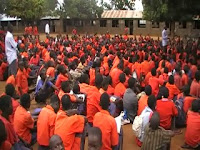Since the late 1980s Uganda has rebounded from the abyss of civil war and economic catastrophe to become relatively peaceful, stable and prosperous.
 But the lives of hundreds of thousands of people in the north remain blighted by one of Africa's most brutal rebellions. In the 1970s and 1980s Uganda was notorious for its human rights abuses, first during the military dictatorship of Idi Amin from 1971-79 and then after the return to power of Milton Obote, who had been ousted by Amin.
But the lives of hundreds of thousands of people in the north remain blighted by one of Africa's most brutal rebellions. In the 1970s and 1980s Uganda was notorious for its human rights abuses, first during the military dictatorship of Idi Amin from 1971-79 and then after the return to power of Milton Obote, who had been ousted by Amin.During this time up to half a million people were killed in state-sponsored violence.
Since becoming president in 1986 Yoweri Museveni has introduced democratic reforms and has been credited with substantially improving human rights, notably by reducing abuses by the army and the police.At home, the cult-like Lord's Resistance Army (LRA) has perpetrated massacres and mutilations in the north for nearly two decades.
The group's leader has said he wants to run the country along the lines of the biblical Ten Commandments. The violence has displaced more than 1.6 million people and tens of thousands of civilians have been killed or kidnapped. The UN estimates that the group has abducted 20,000 children.
Uganda has won praise for its vigorous campaign against HIV/Aids. This has helped to reduce the prevalence of the virus - which reached 30% in the 1990s - to single-digit figures.
 It’s amazing how much a cup of rice or cornmeal can brighten a child’s day! But that’s exactly what the partners of Feed the Hungry provide for children in Uganda through the Every Child Every Day program. The Effects on the children’s health is immense even down to simple things like hair growth, stronger teeth, and the largest change they see is a significant change in concentration levels and the ability to retain information.
It’s amazing how much a cup of rice or cornmeal can brighten a child’s day! But that’s exactly what the partners of Feed the Hungry provide for children in Uganda through the Every Child Every Day program. The Effects on the children’s health is immense even down to simple things like hair growth, stronger teeth, and the largest change they see is a significant change in concentration levels and the ability to retain information.
Pastor Solomon, our outreach ministries partner in Uganda helps oversee the assistance of our daily food program at several locations outside the capital city of Kampala. The King Solomon Academy, Good News Evangelical Ministries, Vineyard Christian School, and Little Angels Christian School help bring the love of Christ and provide a hot nutritious lunch to 1400 children daily.
Along with the School curriculum Pastor Solomon Runs a sports outreach, which over weekends ranging from playing chess to netball and the most popular football, in which they have one several under 16 trophies, which sit very proudly on his desk.
Ever mindful of the support that Feed the Hungry provide the program pastor Solomon has now a small farm of around 4 Acres, were he a chickens goats, cows and is looking at creating a fish farm in order to support and expand the school program. He hopes that the farm within a couple of years will support around 400 children enabling the work to outreach to other communities around the Kampala region.
 Through the generosity of our partners and supporters for Feed the Hungry, and our partners on the ground, we can break the bonds of poverty and hunger, and reach out to a people in need.
Through the generosity of our partners and supporters for Feed the Hungry, and our partners on the ground, we can break the bonds of poverty and hunger, and reach out to a people in need.
 Cholera-contaminated drinking water has already claimed over 900 lives…14,000 are sick…and the numbers are sky-rocketing
Cholera-contaminated drinking water has already claimed over 900 lives…14,000 are sick…and the numbers are sky-rocketing











